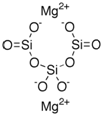Magnesium trisilicate is an inorganic compound that is used as a food additive. The additive is frequently used by fast food chains to absorb fatty acids and extract impurities formed while frying edible oils. It has good acid neutralizing properties.
Manufacture
Prepared from Sodium silicate and Magnesium sulfate.
| Synonyms | Magnesium silicate hydrate, Magnesium silicon oxide |
| CAS no. | 14987-04-3 |
| EINECS no. | 239-076-7 |
| Molecular formula | Mg2O8Si3 |
| Molecular weight | 260.86 |
| Structure |  |
Applications
Magnesium Trisilicate is a common antacid drug that is used for the treatment of indigestion, heartburn, or gastroesophageal reflux disorder (GERD).
| It is also used as |
|---|
| Antioxidant |
| Decolorizing agent |
| Industrial odor absorbent |
SPECIFICATIONS – USP
| Test | Unit | Specification |
|---|---|---|
| Description | – | A white or almost white powder |
| Solubility | – | Practically insoluble in water & in ethanol (96%) |
| Identification | – | A) The Neutralized filtrate responds to the tests for Magnesium B) Silica Floats about in the bead, producing, upon cooling an opaque bead with a web-like structure |
| Water | % | Between 17.0 to 34.0 |
| Soluble salts | – | The residue weight not more than 38.0 mg (1.5%) |
| Chloride | % | Not more than 0.055 |
| Sulfate | % | Not more than 0.5 |
| Free Alkali | – | Not more than 1.0 ml of 0.10 N hydrochloric acid is required |
| Arsenic | ppm | Not more than 8 |
| Acid consuming capacity | – | Between 140 ml to 160 ml of 0.10 N hydrochloric acid |
| Assay as MgO | % | Not less than 20.0 |
| Assay as SiO2 | % | Not less than 45.0 |
| Ratio of SiO2 to MgO | – | Between 2.10 to 2.37 |
STORAGE
The product is stored at ambient temperature protected from moisture
PACKING
25 kg HDPE bags
REGISTRATION / CERTIFICATION
1. WHO-GMP
2. EU-WC (Written Confirmation)
ExSyn offers Magnesium trisilicate on commercial scales and welcomes enquiries. No matter the quantity you need, our exceptional quality and service will make ExSyn your supplier of choice! If you need any additional information or SDS, please contact us.
Iodine is anon-metallic, dark-grey/purple-black, lustrous, solid element. It is the heaviest and the rarest of stable halogens that can be found on the crust of earth.About fifty percent of all iodine produced and manufactured worldwide is used to form Organoiodine compounds. Iodine is an important element for many health-sustaining processes and essential for human thyroid health.
The product, acronymed Oct-NBE, is an organic compound with a cyclic ring system and a 8-membered hydrophobic chain. The structure renders the chemical special properties leading to its applications in diverse fields.
Nicotine is a hygroscopic, colorless to slight yellow, oily liquid, that is readily soluble in alcohol, ether or light petroleum. It is widely used recreationally as a stimulant and anxiolytic.
The product, acronymed ETD, is an organic compound with a fused bicyclic ring system and an ethylidene group. The structure renders the chemical special properties leading to its applications in diverse fields.
Sodium perchlorate monohydrate is the inorganic compound with the chemical formula NaClO4•H2O. It is the common existence form of sodium perchlorate, which can gradually absorb water in the air to form the monohydrate. Sodium perchlorate monohydrate is white rhombic crystal which is highly soluble in water and in alcohol. Its capacity to undergo redox reactions, liberating oxygen atoms, has been harnessed in the preparation of specialty chemicals, including pharmaceutical intermediates and fine chemicals.
Triphenylphosphine is a common organophosphorus compound that is frequently abbreviated as PPh3 or Ph3P. It is widely used in organic and organometallic compound synthesis because it is an effective reducing agent as well as a neutral ligand. At room temperature, PPh3 crystals are relatively air-stable and colourless.
Potassium chlorate holds significant importance across various industries due to its diverse applications. This white crystalline compound has been utilized for centuries as an essential ingredient in the production of matches, fireworks, and explosives, owing to its ability to release oxygen upon decomposition.
Podophyllotoxin is a non-alkaloid toxin lignan extracted from the roots and rhizomes of Podophyllum species. It is an organic heterotetracyclic compound that has a Furonaphthodioxole skeleton bearing a 3,4,5-trimethoxyphenyl substituent.
Octadecylphosphonic acid (ODPA), a versatile chemical compound, serves as a surfactant and dispersant in applications spanning coatings, lubricants, and corrosion inhibition. With its hydrophobic octadecyl chain linked to a phosphonic acid group, it excels in surface modification, boosting adhesion in metal surfaces.
